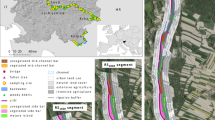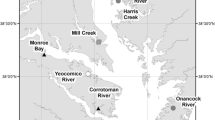Abstract
Estuaries are dynamic transition zones linking freshwater and oceanic habitats. These productive ecosystems are threatened by a variety of stressors including human modification of coastal watersheds. In this study, we examined potential linkages between estuarine condition and the watershed using multimodel inference. We examined attributes at the watershed scale as well as those associated with riparian areas but found that they were highly correlated. We also examined whether attributes closer to the estuary were more strongly related to benthic invertebrate condition and found that this was not generally true. In contrast, variability within the estuary strongly impacted model results and suggests that future modeling should incorporate estuarine variability or focus on the individual stations within the estuary. Modeling estuarine condition indicated that inherent landscape structure (e.g., estuarine area, watershed area, watershed:estuary ratio) is important to predicting benthic invertebrate condition and needs to be considered in the context of watershed/ estuary planning and restoration.





Similar content being viewed by others
References
Anderson, J.R., E.E. Hardy, J.T. Roach, R.E. Witmer. (1976). A land use and land cover classification system for use with remote sensor data. Geological survey professional paper 964. United States Department of the Interior, Washington, D.C.
Arnold, C. L., & Gibbons, C. J. (1996). Impervious surface coverage: the emergence of a key environmental indicator. Journal of the American Planning Association, 62, 243–257.
Beal, D. J. 2007. Information criteria methods in SAS for multiple linear regression models. SESUG Proceedings, 15th annual Southeast SAS Users Group Conference, 4-6 November 2007, Hilton Head, SC. Paper SA05:1–10.
Bilkovic, D. M., Roggero, M., Hershner, C. H., & Havens, K. H. (2006). Influence of land use on macrobenthic communities in nearshore estuarine habitats. Estuaries and Coasts, 29, 1185–1195.
Burnham, K. P., & Anderson, D. R. (2002). Model selection and multimodel inference: a practical information-theoretic approach (2nd ed.). New York: Springer-Verlag.
Burkholder, J., Libra, B., Weyer, P., Heathcote, S., Kolpin, D., Thorne, P. S., & Wichman, M. (2007). Impacts of waste from concentrated animal feeding operations on water quality. Environmental Health Perspectives, 115, 308–312.
Comeleo, R. L., Paul, J. F., August, P. V., Copeland, J., Baker, C., Hale, S. S., & Latimer, R. W. (1996). Relationships between watershed stressors and sediment contamination in Chesapeake Bay estuaries. Landscape Ecology, 11, 307–319.
Day, J. W., Britsch, L. D., Hawes, S. R., Shaffer, G. P., Reed, D. J., & Cahoon, D. (2000). Pattern and process of land loss in the Mississippi delta: a spatial and temporal analysis of wetland habitat change. Estuaries, 23, 425–438.
Dauer, D. M., Weisberg, S. B., & Ranasinghe, J. A. (2000). Relationships between benthic community condition, water quality, sediment quality, nutrient loads, and land use patterns in Chesapeake Bay. Estuaries, 23, 80–96.
Dauvin, J., Bellan, G., & Bellan-Santini, D. (2010). Benthic indicators: from subjectivity to objectivity – where is the line? Marine Pollution Bulletin, 60, 947–953.
Edgar, G. J., & Barrett, N. S. (2000). Effects of catchment activities on macrofaunal assemblages in Tasmanian estuaries. Estuarine, Coastal and Shelf Science, 50, 639–654.
Engle, V. D., & Summers, J. K. (1999). Refinement, validation, and application of a benthic condition index for Gulf of Mexico estuaries. Estuaries, 22, 624–635.
Engle, V. D., Kurtz, J. C., Smith, L. M., Chancy, C., & Bourgeois, P. (2007). A classification of U.S. estuaries based on physical and hydrologic attributes. Environmental Monitoring and Assessment, 129, 397–412.
Gillett, D. J., Weisberg, S. B., Grayson, T., Hamilton, A., Hansen, V., Leppo, E. W., Pelletier, M. C., Borja, A., Cadien, D., Dauer, D., Diaz, R., Dutch, M., Hyland, J. L., Kellogg, M., Larsen, P. F., Levinton, J. S., Llansó, R., Lovell, L. L., Montagna, P. A., Pasko, D., Phillips, C. A., Rakocinski, C., Ranasinghe, J. A., Sanger, D. M., Teixeira, H., VanDolah, R. F., Velarde, R. G., & Welch, K. I. (2015). Effect of ecological group classification schemes on performance of the AMBI benthic index in US coastal waters. Ecological Indicators, 50, 99–107.
Hale, S. S., Paul, J. F., & Heltshe, J. F. (2004). Watershed landscape indicators of estuarine benthic condition. Estuaries, 27, 283–295.
Holland, A. F., Sanger, D. M., Gawle, C. P., Lerberg, S. B., Santiago, M. S., Riekerk, G. H. M., Zimmerman, L. E., & Scott, G. I. (2004). Linkages between tidal creek ecosystems and the landscape and demographic attributes of their watersheds. Journal of Experimental Marine Biology and Ecology, 298, 151–178.
Homer, C. C. H., Yang, L., Wylie, B., & Coan, M. (2004). Development of a 2001 national landcover database for the United States. Photogrammetric Engineering and Remote Sensing, 70, 829–840.
Howarth, R. W., Sharpley, A., & Walker, D. (2002). Sources of nutrient pollution to coastal waters in the United States: implications for achieving coastal water quality goals. Estuaries, 25, 656–676.
King, R. S., Beaman, J. R., Whigham, D. F., Hines, A. H., Baker, M. E., & Weller, D. E. (2004). Watershed land use is strongly linked to PCBs in white perch in Chesapeake Bay subestuaries. Environmental Science and Technology, 38, 6546–6552.
King, R. S., Hines, A. H., Craige, F. D., & Gap, S. (2005a). Regional, watershed and local correlates of blue crab and bivalve abundances in subestuaries of Chesapeake Bay, USA. Journal of Experimental Marine Biology and Ecology, 319, 101–116.
King, R. S., Baker, M. E., Whigham, D. F., Weller, D. E., Jordon, T. E., Kazyak, P. F., & Hurd, M. K. (2005b). Spatial considerations for linking watershed land cover to ecological indicators in streams. Ecological Applications, 15, 137–153.
Lerberg, S. B., Holland, A. F., & Sanger, D. M. (2000). Responses of tidal creek macrobenthic communities to the effects of watershed development. Estuaries, 23, 838–853.
Little, C. (2000). The biology of soft shores and estuaries. New York: Oxford University Press.
Mayer, P. M., Reynolds, S. K., Jr., McCutchen, M. D., & Canfield, T. J. (2007). Meta-analysis of nitrogen removal in riparian buffers. Journal of Environmental Quality, 36, 1172–1180.
O’Neill, R. V., Hunsaker, C. T., Jones, K. B., Ritters, K. H., Wickham, J. D., Schwartz, P. M., Goodman, I. A., Jackson, B. L., & Bailargeon, W. S. (1997). Monitoring environmental quality at the landscape scale. BioScience, 47, 513–519.
Paul, J. F., Scott, K. J., Campbell, D. E., Gentile, J. H., Strobel, C. S., Valente, R. M., Weisberg, S. B., Holland, A. F., & Ranasinghe, J. A. (2001). Developing and applying a benthic index of estuarine condition for the Virginian Biogeographic Province. Ecological Indicators, 1, 83–99.
Paul, J. F., Comeleo, R. L., & Copeland, J. (2002). Landscape metrics and estuarine sediment contamination in the mid-Atlantic and southern New England regions. Journal of Environmental Quality, 31, 836–845.
Paul, M. J., & Meyer, J. L. (2001). Streams in urban landscapes. Annual Review of Ecology and Systematics, 32, 333–365.
Paerl, H. W., Valdes, L. M., Pickney, J. L., Piehler, M. F., Dyble, J., & Moisander, P. H. (2003). Phytoplankton photopigments as indicators of estuarine and coastal eutrophication. Bioscience, 53, 953–964.
Pearson, T. H., & Rosenberg, R. (1978). Macrobenthic succession in relation to organic enrichment and pollution of the marine environment. Oceanography and Marine Biology. Annual Review, 16, 229–311.
Pelletier, M. C., Gold, A. J., Gonzalez, L., & Oviatt, C. (2012). Application of multiple index development approaches to benthic invertebrate data from the Virginian Biogeographic Province, USA. Ecological Indicators, 23, 176–188.
Pelletier, M. C., Gillett, D. J., Hamilton, A., Grayson, T., Hansen, V., Leppo, E. W., Weisberg, S. B., & Borja, A. (2018). Adaptation and application of multivariate AMBI (M-AMBI) in US coastal waters. Ecological Indicators, 89, 818–827.
Pinto, R., Patrício, J., Baeta, A., Fath, B. D., Neto, J. M., & Marques, J. C. (2009). Review and evaluation of estuarine biotic indices to assess benthic condition. Ecological Indicators, 9, 1–25.
Potter, K. M., Cubbage, F. W., & Schaberg, R. H. (2005). Multiple-scale landscape predictors of benthic macroinvertebrate community structure in North Carolina. Landscape and Urban Planning, 71, 77–90.
Rakocinski, C. F., Brown, S. S., Gaston, G. R., Heard, R. W., Walker, W. W., & Summers, J. K. (1997). Macrobenthic responses to natural and contaminant-related gradients in northern Gulf of Mexico estuaries. Ecological Applications, 7, 1278–1298.
Rhoads, D. C. (1974). Organism-sediment relations on the muddy sea floor. Oceanography and Marine Biology. Annual Review, 12, 63–300.
Sakamaki, T., Shum, J. Y. T., & Richardson, J. S. (2010). Watershed effects on chemical properties of sediment and primary consumption in estuarine tidal flats: Importance of watershed size and food selectivity by macrobenthos. Ecosystems, 13, 328–337.
SAS Institute Inc. (2015). SAS/IML 14.1 User’s Guide. Cary: SAS Institute Inc..
Seitz, R. D., Knick, K. E., Davenport, T. M., & Saluta, G. G. (2018). Human influence at the coast: upland and shoreline stressors affect coastal macrofauna and are mediated by salinity. Estuaries and Coasts, 41, 114–130.
Silverman, B. W. (1986). Density estimation for statistics and data analysis. New York: Chapman and Hall.
Soetaert, K., Vincx, M., Wittoeck, J., & Tulkens, M. (1995). Meiobenthic distribution and nematode community structure in five European estuaries. Hydrobiologia, 311, 185–206.
Snelgrove, P. V. R. (1998). The biodiversity of macrofaunal organisms in marine sediments. Biodiversity and Conservation, 7, 1123–1132.
Sponseller, R. A., Benfield, E. F., & Vallett, H. M. (2001). Relationships between land use, spatial scale and stream macroinvertebrate communities. Freshwater Biology, 46, 1409–1424.
Thrush, S. F., Hewitt, J. E., Cummings, V. J., Ellis, J. L., Hatton, C., Lohrer, A., & Norkko, A. (2004). Muddy waters: elevating sediment input to coastal and estuarine habitats. Frontiers in Ecology and the Environment, 2, 299–306.
Trombulak, S. C., & Frissell, C. A. (2000). Review of ecological effects of roads on terrestrial and aquatic communities. Conservation Biology, 14, 18–30.
Weisberg, S. B., Ranasinghe, J. A., Schaffner, L. C., Diaz, R. J., Dauer, D. M., & Frithsen, J. B. (1997). An estuarine index of biological integrity (B-IBI) for Chesapeake Bay. Estuaries, 20, 149–158.
Weller, D. E., Jordan, T. E., & Correll, D. L. (1998). Heuristic models for material discharge from landscapes with riparian buffers. Ecological Applications, 8, 1156–1169.
U.S. EPA. (2001). National Coastal Assessment: Field Operations Manual. EPA/620/R-01/003. Gulf Breeze: United States Environmental Protection Agency, Office of Research and Development, National Health and Environmental Effects Laboratory.
Venice System. (1958). Venice system symposium on the classification of brackish waters. Venice, April 8–14, 1958. Archives Oceanography and Limnology, 11(Suppl), 1–248.
Zuur, A. F., Ieno, E. N., Walker, N. J., Saveliev, A. A., & Smith, G. M. (2009). Mixed effects models and extensions in ecology with R. New York: Springer Science and Business Media.
Acknowledgements
We would like to thank the EMAP field crews and IT staff for providing the data used in this study, Mike Charpentier for map production, Nina Bonnelycke for helpful advice on the USDA Agricultural Survey, Alisa Morrison for helpful conversations, and Jim Latimer, Hal Walker, and Jonathan Serbst for their technical reviews.
Disclaimer
The views expressed in this manuscript are those of the authors and do not necessarily represent the views or policies of the U.S. Environmental Protection Agency. Any mention of trade names, products, or services does not imply an endorsement by the U.S. Government or the U.S. Environmental Protection Agency. The EPA does not endorse any commercial products, services, or enterprises. This is STICS ORD-027080.
Author information
Authors and Affiliations
Corresponding author
Additional information
Publisher’s note
Springer Nature remains neutral with regard to jurisdictional claims in published maps and institutional affiliations.
Electronic supplementary material
ESM 1
(DOCX 31 kb)
Rights and permissions
About this article
Cite this article
Pelletier, M.C., Gold, A.J., Copeland, J. et al. Landscape structure and land use affect estuarine benthic invertebrates in the Virginian Biogeographic Province, USA. Environ Monit Assess 191, 252 (2019). https://doi.org/10.1007/s10661-019-7401-8
Received:
Accepted:
Published:
DOI: https://doi.org/10.1007/s10661-019-7401-8




